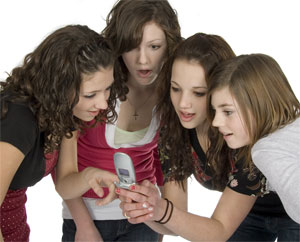 |
| Young girls play at "being bad" through gossiping and bullying. |
A barrage of media reports about a generation of violent youth contrasts with what criminologists, police and governments are telling us: that crime among young people is decreasing and that our streets are safer than ever before. Police explain our perceptions as the result of a very small number of youth committing a few very troubling acts. Our hyperbolic media, coupled with zero tolerance for risk has made us sensitive to youth violence whether it occurs on the Halifax Commons or anywhere else in Canada. Reassuring statistics aside, it feels like this next generation is less responsible and more violent than their parents.
The question persists: Why are a few youth behaving violently? And in particular, why are violent girls appearing more often in the news? We can look at the problem in at least three ways. None blame the violence on the kids alone. All implicate families and communities in the solutions.
Explanation one: Pushed out and disengaged. For well over a century, we’ve known that feeling disengaged from our families and communities leads to a host of problems that include both depression and its fraternal twin, violence. The young person who seeks to belong, feel competent, responsible and make a contribution will find among delinquents an easily negotiated role and emotional and financial security resulting from antisocial behaviour. While we have been loath to name the causes of the problem, it is economically marginalized youth and those who are academically at-risk that are most likely to be the troublemakers in our communities. Excluded kids have to find their own ways to feel powerful.
Explanation two: Playing at being bad. Delinquent and deviant behaviour brings with it powerful identity stories that youth chose when choices are few. Experimenting with playing the bad kid is a strategy some use to find adventure, risk, and the thrill of rebellion. Far from being pressured into bad behaviour, youth account for their experimentation with violence and delinquency as a search for the most powerful identity available with which to align themselves. Studies of bullies, street youth and delinquents find among these youth positive self-images. Even young women are looking for this same sense of power.
Young people talk of inflexible educational systems that reject their learning styles, disabilities that present them with barriers to success, and a marginalized status in their communities because of their race, ethnicity, and sexual orientation. In their search for something powerful to say about themselves, stealing cars can be a substitute for academic prowess, violence a substitute for physical performance, drug abuse a rite of passage into adulthood.
Explanation three: The lesser evolved child. We look at young people as less evolved phylogenetically. It is as if child development advances children through evolutionary stages from wild animals to more evolved humans. The result is our ambivalence about kids. We infantilize them while expecting them to act as rationally as their elders. Robert Epstein’s recent book The End of Adolescence shocked us with its proposal that we let 14-year-olds vote. On the other hand, David Elkind worries over The Hurried Child who is pushed too early to take responsibility. The U.N. Convention on the Rights of the Child ensures children remain children, protected from exploitive labour practices and adult justice. Meanwhile, young people who act out violently are often fed up with being warehoused on the margins of their communities: they are told endlessly what they can’t do rather than being given responsibility for themselves and others.
So which is it? Are youth irresponsible (less-evolved) beings needing control, or fully functioning beings deserving of both rights and responsibilities?
In the absence of rites of passage to transition to adulthood, and wasted years in school where education is divorced from its practical applications for students who are less academically inclined, violence and delinquency become for some a way to feel grown up and competent.
Substitutions: It comes down to substitutions. Whether we believe young people turn violent because of their disengagement, search for a powerful identity, or desire for a status as adult, the onus is on our communities to do more than suppress bad behaviour. To succeed, we will have to offer substitutes to violent youth that bring them just as many advantages as what they find through their violence. That means offering even our most violent young people the feeling they belong in their communities, have responsibilities for others, and have strengths that others value. Achieving this doesn’t mean more police. It means more of the model efforts that are already proving successful across this country. The downward trending statistics tell us decades of progressive social programming is working even if we’re still afraid to walk the Halifax Commons.
 | Michael Ungar, Ph.D. is the author of Too Safe for their Own Good: How Risk and Responsibility Help Teens Thrive and Playing at Being Bad: The Hidden Resilience of Troubled Teens (see www.michaelungar.com). He is currently a University Research Professor and Professor at the School of Social Work where he specializes in working with troubled youth and their families. |
Comments
comments powered by Disqus
